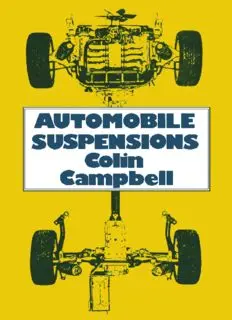
Automobile Suspensions PDF
Preview Automobile Suspensions
Automo bile Suspensions AutoInobile Suspensions COLIN CAMPBELL M.Sc., C.Eng., M.I.Mech.Engrs LONDON CHAPMAN AND HALL First published 1981 by Chapman and Hall Ltd 11 New Fetter Lane, London EC4P 4EE © 1981 C. Campbell Softcover reprint of the hardcover 1st edition 1981 ISBN-13: 978-0-412-16420-0 (cased edition) ISBN-13: 978-1-4613-3391-3 (paperback edition) This title is available in both hardbound and paperback editions. The paperback edition is sold subject to the condition that it shall not, by way of trade or otherwise, be lent, re-sold, hired out, or otherwise circulated without the publisher's prior consent in any form of binding or cover other than that in which it is published and without a similar condition including this condition being imposed on the subsequent purchaser All rights reserved. No part of this book may be reprinted, or reproduced or utilized in any form or by any electronic, mechanical or other means, now known or hereafter invented, including photocopying and recording, or in any information storage or retrieval system, without permission in writing from the publisher British Library Cataloguing in Publication Data Campbell, Colin Automo bile suspensions 1. Automobiles - Springs and suspension I. Title 629.2' 43 TL 257 80-41445 ISBN-13: 978-1-4613-3391-3 e-ISBN-13: 978-1-4613-3389-0 DOl: 10.1007/978-1-4613-3389-0 TO THE MEMORY OF MAURICE OLLEY who introduced us to the benefits of independent suspension Contents Preface page ix 1 Wheels and tyres 1 2 Springs 22 3 Suspension principles 41 4 Suspension geometry 54 5 Conventional systems 77 6 Road -holding 105 7 Dampers 120 8 Pneumatic suspensions 129 9 Hydropneumatic suspensions 143 10 Interconnected and no-roll suspensions 165 11 A small FWD saloon car: Ford Fiesta S 185 12 A high-performance sports car: Porsche 928 198 Index 211 We have had enough of action and of motion we, Roll'd to starboard, roll'd to larboard, When the surge was seething free. Alfred Lord Tennyson Preface This book is an introduction to the elementary technology of automobile suspensions. Inevitably steering geometry must be included in the text, since the dynamic steering behaviour, road-holding and cornering behaviour are all influenced by the suspension design. Steering mechanisms and steering components are not covered in this book. This is not a mathematical treatise, but only a fool or a genius would attempt to design a motor vehicle without mathematics. The mathematics used in this book should present no problem to a first-year university student. SI units have been used in general, but for the benefit of those not familiar with them we have included in brackets, in many cases, the equivalent values in Imperial units. Many engineers regard the Pascal as an impractical unit of pressure. The author has therefore expressed pressures in bars (1 bar = 105Pa). A deviation from SI units is the use of degrees and minutes, instead of radians, to express camber, castor, roll angles, etc. This is still common practice in the motor industry. No attempt has been made to make any stress calculations on suspension components. The automobile engineering student will have access to other textbooks on such subjects as strength of materials and theory of structures. The author is grateful for technical information, photographs and drawings supplied by many car and component manufacturers. The following companies have been particularly helpful: Automotive Products Ltd, Citroen Cars Ltd, Datsun (UK) Ltd, Dunlop Ltd, Lotus Cars Ltd, Lucas-Girling Ltd, Magnesium Elektron Ltd (MELMAG wheels), Mercedes-Benz (UK) Ltd, Moulton Developments Ltd (Hydragas suspension), Porsche Cars (GB) Ltd, Tech Del Ltd (Minilite wheels). Special thanks are due to the editor of Motor for his permission to publish data from 'The 150 m.p.h. Corner', a x Preface report (3 March 1979) in that excellent journal, givmg measurements made with the assistance of the Cranfield Institute on the Lotus 79 when cornering at 2.05g radial acceleration. c.c. 1 Wheels and Tyres 1.1 Suspension The term suspension suggests 'supporting from above', as in 'suspension bridge' or 'suspender', since the earliest forms of suspension used on the roads did literally suspend the body of the horse-drawn carriage at the four corners by very flexible leaf springs with outer ends that curved over and upwards to join the shackle pins in the carriage frame. In the modern automobile suspension plays a dual role. It 'suspends' the body on a shock-absorbing system and at the same time maintains the contact patches of the four tyres in effective contact with the road surface. One cannot overemphasize the importance of this second role. If we fail in this, the driver cannot control the vehicle. Rally drivers are well aware that effective road contact is sometimes lost. They wear safety harnesses and crash helmets to reduce the dangers from this eventuality and the backup crew carry a host of spares to repair the damage. Even so, a good suspension system under normal conditions keeps all four wheels in contact with the road surface and makes it possible for a driver of average ability to keep the vehicle under satisfactory directional control. A bad suspension system fails to do this under identical road conditions. It is perfectly logical therefore to begin our analysis of suspension systems from the bottom, since the car's four areas of contact with the road surface made by the tyres (footprints, in American terminology) are so vital to the behaviour of the vehicle when in motion. This leads us then to the wheels and the tyres. 1.2 The wheel Nobody knows who invented the wheel. That delightful American strip-cartoon series Be, suggested that their most
